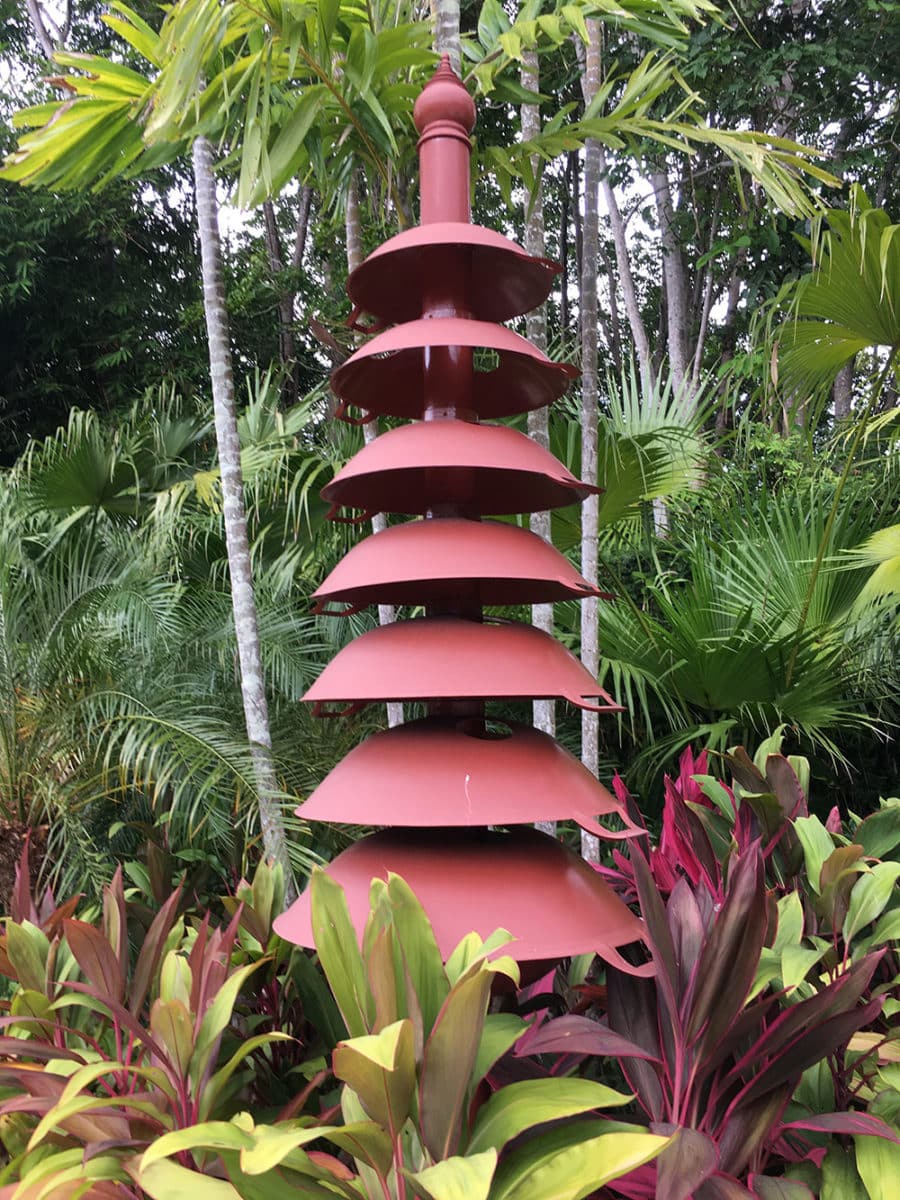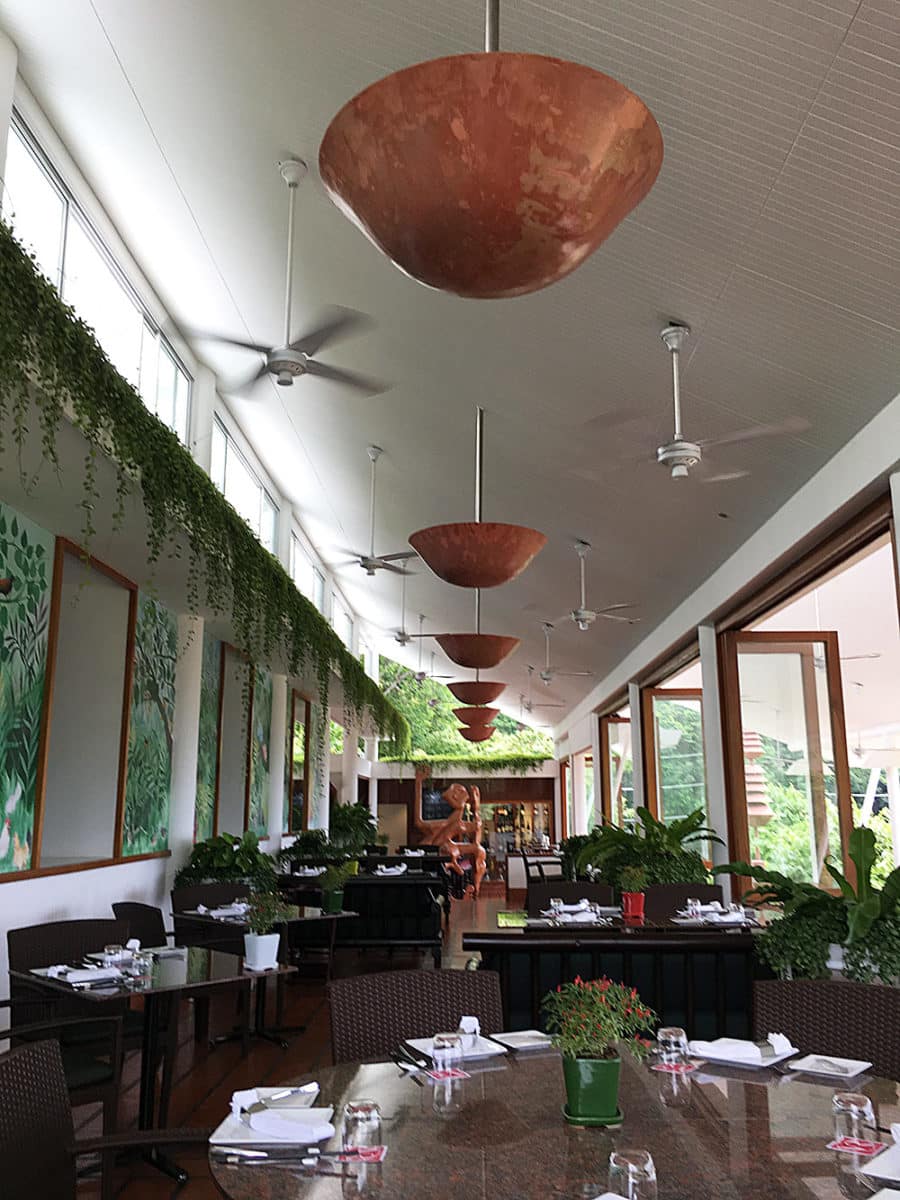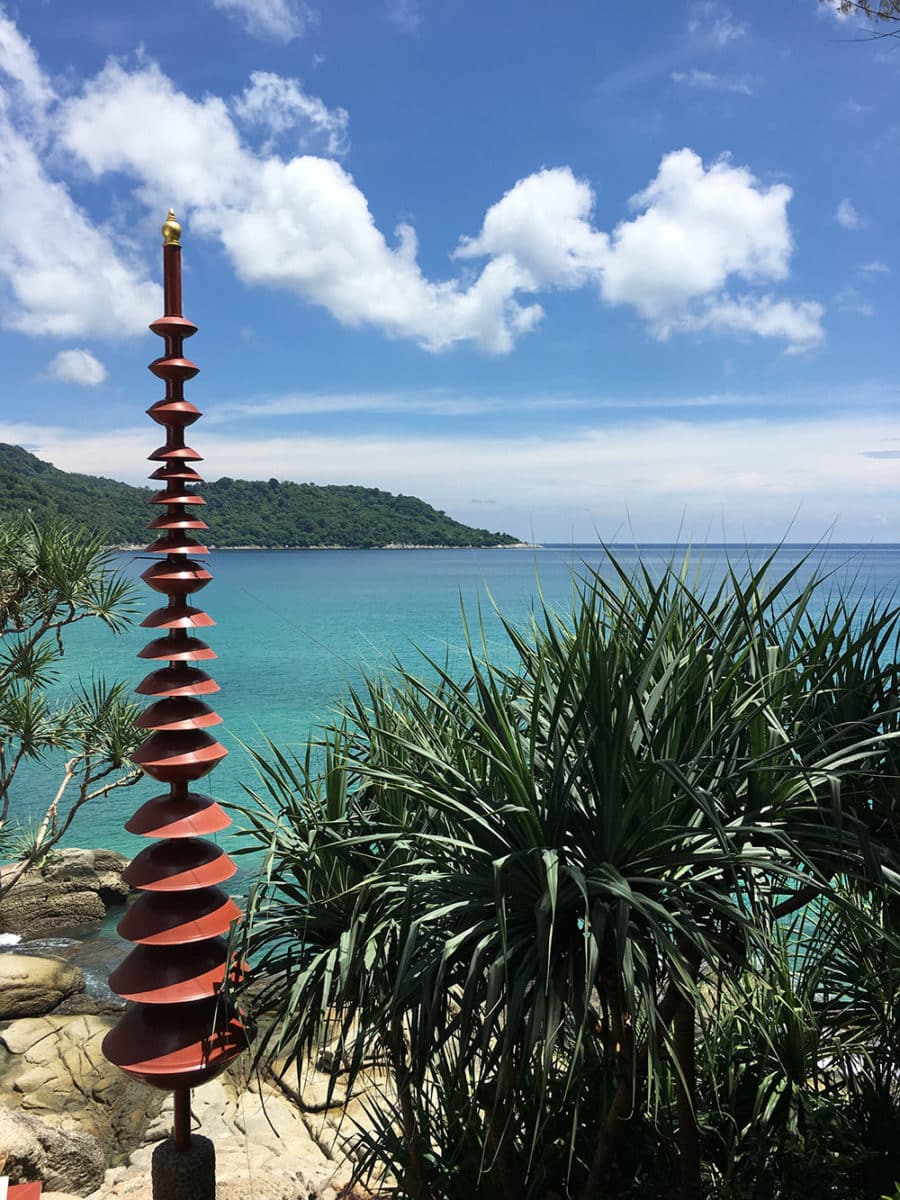It began with a wok. The light fixtures around the hotel compound had started to wear and he thought of replacing them. An idea came to him as he happened to look at a wok. The shape caught his imagination, and it was durable, plentiful, and cheap. Imagining the wok turned upside down, he thought to himself that it would make an intriguing outdoor fixture.
And so he set to work. One of his staff was instructed to buy hundreds of metal woks, cleaning out the supplies of woks all over the island of Phuket in southern Thailand. Next, another staff member was instructed to paint them, some in the color of terra cotta and others forest green. They were mounted upside-down with the wok’s handles perfectly fastened to the sides of light fixtures over the entire hotel compound. Woks everywhere. As the sun went down and lights were switched on, the woks’ painted domes turned as dark as night, with halos of light spreading underneath, brightly illuminating the walkways. They were as perfect, as any outdoor lamp should be.


As he sat one evening at dinner on the lowest terrace of the hotel restaurant overlooking the magnificent turquoise Andaman Sea, there seemed to be an empty spot that caught his attention. It called for a sculpture. Why not a light sculpture? he thought. And so it appeared, a series of woks stacked one on top of another, the larger sizes at the bottom supporting smaller ones ascending toward the sky, up and up into the shape of a pagoda. He had some of them drilled with holes to let the lights shine through, and when the switch was turned on the sculpture lit up the night sky, mysterious and brilliant as a pagoda.
Mom Luang (an honorific title) Tridhosyuth Devakul, known as Mom Tri, is a renaissance man. He was sent to America, when he was barely nine years old, to be brought up by a family friend, Dean Francis Bowes Sayre, Jr. of Washington National Cathedral. After he graduated from Harvard with a degree in architecture, he returned to Thailand, young, fresh and handsome, to try to get a footing in his native land that had become unfamiliar to him. With a passion for art, food, and spirits, he embarked on a creative adventure that has left a permanent imprint on Phuket.
Decades ago, when Phuket was a wild island known only to handfuls of urbane Thais and foreigners, Mom Tri’s uncle, Prince Sanit Rangsit, owned a piece of land known today as Kata beach. Mom Tri would fly there on a small local Thai airline to visit his uncle’s summer home.
The island’s dense forests, mountains and hills overlooked the expanse of the blue crystal clear water of the Andaman Sea surrounded by blindingly white sand beaches. The landscape took grip of his heart and mind and would not let go. Mom Tri’s cordial and easy-going nature won him entry into the local fishermen’s homes where they cooked and feasted with freshly caught sea foods. Slowly, his uncle’s unpretentious beach house became the getaway for his intimate friends and family members, with entertainment and dining on Phuket’s rustic and empty beach.
Mom Tri did the cooking with the help from local families, preparing dishes using freshly caught fish and shellfish. The tables were set with fine linens, china, crystal glasses and silverware. The meals were served with the best wines and spirits. His consideration of his foreign friends’ tastes resulted in newly-invented fusion dishes. He began with local fare, evolving and melding it with the flavors and style of western foods.
Friends — including ambassadors, princes and princesses, famous authors, movie stars and renowned chefs — became a part of his beach entourage in Phuket. Small huts were renovated into elegant abodes. He eventually bought his uncle’s land as well as additional properties. To entice Thai Airways to expand their service to Phuket, he designed and built the first international hotel, Club Med, combining Thai traditional architecture with western comforts. From there onward, there was no stopping others to do what he started and continues until today; Phuket is now the busiest vacation destination for foreign visitors to Thailand.
The expansion of the island is not in Mom Tri’s control, although he tried in the past, when he served as a senator, to guide its growth. However, his summer home today, a hotel called Mom Tri’s Villa Royale, is very much under his loving management. The inspiration of woks did not stop with light fixtures and sculptures, but continued with Wok Pagoda; a restaurant perched high over a mountain top overlooking Chalong Bay.
This gleaming new restaurant with an impressive state-of-the-art kitchen can prepare meals for hundreds of guests. Woks adorn the restaurant as light fixtures and light pagodas. The space, combining glass and wood, is nestled among the brilliant colors of a cultivated garden and the wild forest. From every corner can be seen the view of Chalong Bay and the specks of distant moored boats.
It is a dining space that accommodates the island’s changing seasons. Large windows and doors circulate the air and dissipate humid summer heat. When the monsoon season ushers in torrential rain and powerful wind, the windows and doors can be closed strategically, enough to cool yet also protect the guests as they dine. The cool season with its gentle wind that tempers the intense sun is the high season for vacationing foreign visitors.

The restaurant beckons diners to come and gaze at the view. However, it is with the food that Mom Tri hopes to seduce his guests.
Chef Tammanoon Panchun began working with Mom Tri about thirty years ago when he first graduated with a hospitality and culinary degree. Together they became the culinary team that created the recipes for Wok Pagoda. The food is fusion cooking, combining Thai with other Asian and western influences.
To Mom Tri, fusion cooking is the way he has cooked all his life, combining his favorite dishes regardless of their origins. It was the way Thais have always cooked, although traditionalists might be reluctant to admit it. Even the famous dish Pad Thai is not authentically Thai. Originally Chinese — or some claim, Vietnamese — it was invented to please Thai taste buds. The basic technique of cooking Pad Thai does not rely on a fixed recipe. The one essential ingredient is the noodle; everything else is left to the inventiveness of the cook. Renowned and ancient Thai curries, salads, and desserts were created from borrowed recipes of other countries influenced by Thai taste and preference. Mom Tri believes that Thai foods owe their fame to the creative genius of cooks like his aunt and mother, who learned ancient recipes and employed their own gifts as they cooked.
Mom Tri built Wok Pagoda’s menu carefully. Several dishes were chosen because he created them many decades ago for his friends and families during their visits to Phuket, some adapted from traditional Thai recipes. Tom Yam Heang, a hot-and-sour soup, became a stir-fry, using whipped cream instead of coconut milk as a base for roasted chilies in oil, lemongrass, galangal, kaffir lime leaves, lime juice, palm sugar and fish sauce. Instead of the customary fillets of fish, giant ocean prawns are added to the aromatic sauce.
Another common Thai dish, Ped Paloh — duck slow-cooked in a sauce flavored with Chinese five spices — has been given a French twist. Paloh seasonings are used as a marinade for the duck, which is then cooked as a confit. For a touch of Thai surprise and contrast, just before serving, the dish is garnished with fragrant crispy garlic.
Mom Tri faced a dilemma when wanting to serve grilled pork chops. Most Thai dishes using pork would first slice it into bite-sized pieces, slivered or minced. To solve the problem of toughness in a thick cut of meat, he made a marinade combining apple juice, thyme, garlic, fish sauce, chili and butter. This made the grilled chop juicy and tender.
Another one of his creations was inspired while he was eating at a Japanese restaurant. He noticed some Chinese diners standing around a table, using their chopsticks to hold a fried fish upright on a plate while at the same time picking off the meat. He was intrigued. It resulted in his invention of small metal rods that would support a whole crispy fried fish upright on a plate. A new dish was created and named “swimming fish,” served in a sea of sauce made with tomatoes, white wine, olives, and capers.
Every detail of Wok Pagoda has been carefully executed. Woks of all sizes are used as serving dishes and wine buckets. The staff, from cooks to servers and dishwashers, are handpicked by Mom Tri, with many personally trained by him in the art of restaurant service. Some who were once shy and introverted become star servers, entertaining and charming the guests.
To be at Wok Pagoda and to savor the dishes it offers is to experience what it was like decades ago, when Mom Tri entertained and cooked for his intimate circles. It is a rare encounter with a remarkable man whose imagination has become richer with age and life’s experience, and who has learned about hospitality in the best possible way, making his friends feel welcomed and treasured.
You can find Mom Tri’s Villa Royale at 12 Kata Noi Road, Kata Noi Beach, Phuket 83100 Thailand. Visit their webpage at www.villaroyalephuket.com. ![]()